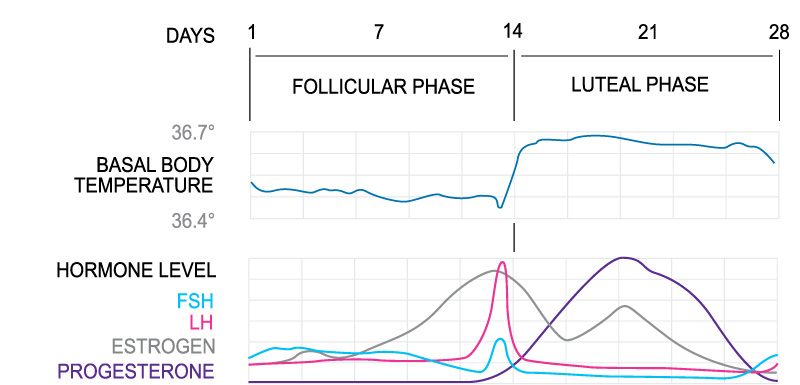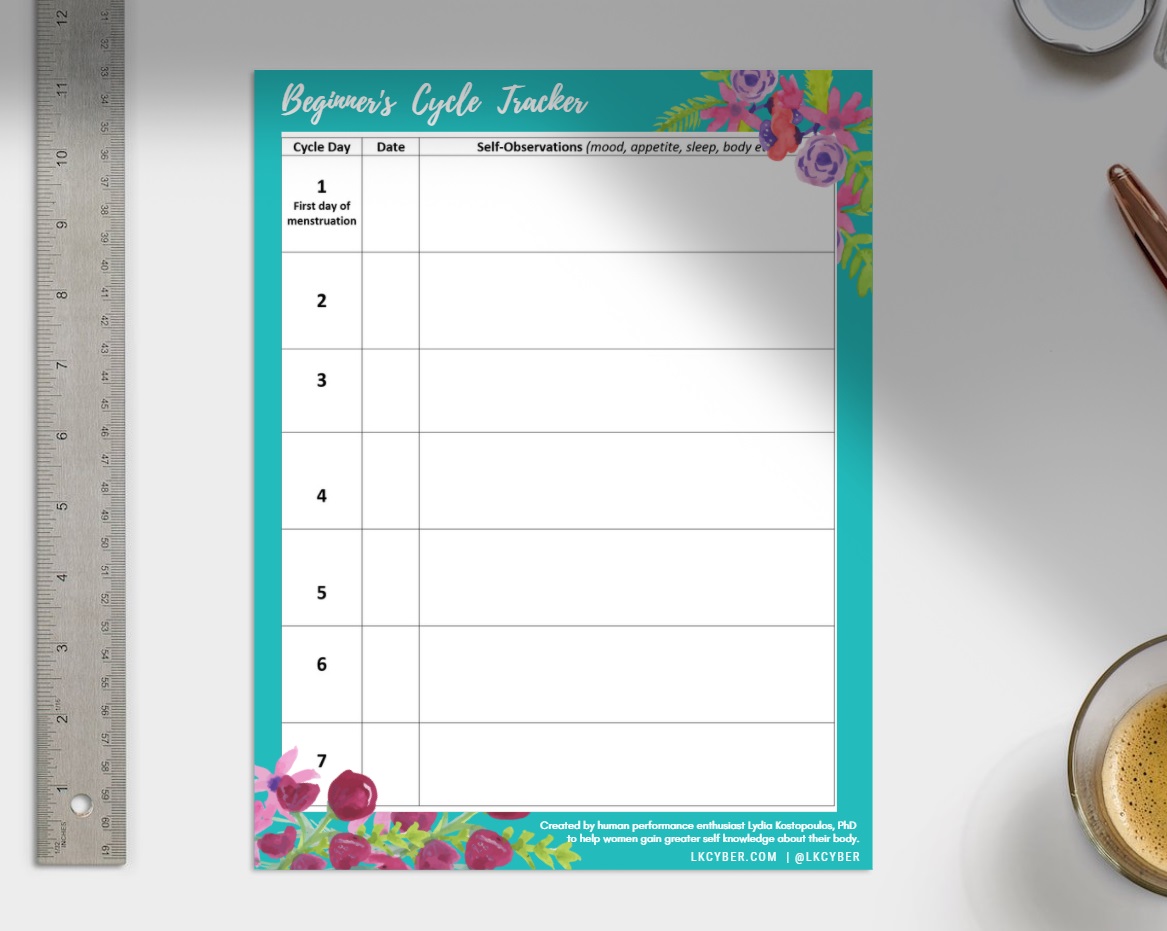
For one of the most important bodily experiences, the nuances of how the menstrual cycle works remains to be a mystery for most. In school pre-teen girls are given some form of a “talk” about their period and how pregnancies happen. But one would be hard pressed to find schools informing these newly menstruating girls about how and which hormones flow throughout the cycle, what they mean for the body and mind and how they should posture for these cyclical ebbs and flows which they will experience for several decades. Later in adult life, gynecologists possibly assume that women already understand how the body works and in particular how their own body works and do not tend to go through all the phases of the menstrual cycle to explain what it means for “human performance”. Instead, more often than not, the discussion relating to phases in the cycle revolves around fertility and tracking the ovulation phase. However, knowledge about the entire cycle and what it means for exercise performance, cognitive performance or even self-awareness is not widely understood; when it should be a pillar in women’s human performance.
In fact, the term “human performance” itself is relatively new, as is our collective social awareness about the potential to improve the capabilities of our body. Being a relatively new concept, there are many variations of the definition of human performance which can be understood to be primarily about psychology and physiology. It encompasses a range of multi-disciplinary fields which have the broad intent to better understand how the human body works and how to maximize its potential, reduce or minimize performance degradation and, where possible, expand existing capabilities. But any endeavor towards improvement starts with establishing a baseline to understand the status quo. This starts with data collection. In this case, the desire is to improve the menstrual cycle experience, hence ‘menstrual cycle performance’. I define “menstrual cycle performance” as all things relating to improving the lived and embodied experience throughout the menstrual cycle, while maximizing the positive aspects and minimizing and mitigating the negative aspects.
As each woman will experience her menstrual cycle differently, it is useful to couple data derived from technology with micro-journaling in an effort to learn more about an individual’s personal cycle in order to create a personal menstrual performance plan.
In this article I discusses how one can collect data through technology and micro-journaling and share my personal menstrual performance insights I gained from this method.
A Wealth of Biological Data in the Palms of Our Hands
Today, in 2021, wearable trackers have reached critical mass with a proliferation of watches, bands, rings and other devices that track a broad range of data. These devices are paired with apps which display a wealth of information that can serve as useful data points to complement a self-observational study of one’s menstrual cycle.
Several fertility apps track the cycle and come with thermometers to measure the Basal Body Temperature (BBT) which “is defined as the lowest natural, non-pathologic body temperature recorded after a period of rest.” Because the temperature is lower in the first part of the cycle and then rises when ovulation occurs, the ‘Temperature Method’ is one way to track ovulation to identify the window of fertility. While the greatest focus on temperature data in relation to the cycle has been around fertility, if examined from the lens of human performance it offers more data to use for sleep and athletic performance.
The following graphic gives an overall snapshot of the menstrual cycle showing the changes in BBT and hormone levels.

The changes in temperature are due to the natural hormonal changes across the menstrual cycle. These are elements that affect sleep and athletic performance. In Arianna Huffington’s book “The Sleep Revolution” she highlights the value of sleep in: athletic performance, cognitive performance, immunity as well as mood. Using a sleep tracker one can get more data on the temperature change, heart rate, as well as resting heart rate (RHR) and heart rate variability (HRV). The Oura ring tracks this and they have written a very insightful article on how women’s body temperature, respiratory heartrate, RHR and HRV change across the phases of the menstrual cycle. They have found that while more research is to be done, the follicular phase “may support peak athletic performance and sociability… [and] higher estrogen levels during the follicular phase may also boost cognition and creativity.”
While there are many similarities between women’s experiences, because women have different lifestyles and use different forms of contraceptives, trackers are a useful way to help establish a personal baseline on one’s own body data. The ability to have such high-quality tracking technology in wearables such as the Oura ring, Garmin, Fitbit give women unprecedented access to their bodies’ information. Apps that cycle sync such as Nike, FITR woman and Wild AI help women leverage their physiology to their advantage to maximize their athletic performance. They connect wearable device data from other devices and provide tailored athletic and sports nutritional advice. Some apps also tailor information based on whether women use birth control or not, or are in their perimenopause or postmenopause phase of their life.
Technology is only getting better to help women gain greater insight about their sleep and help them exercise and eat based on the moments they are in their cycle. But from a systems-thinking perspective, there are other elements beyond food, muscles and sleep to achieve a more personalized and nuanced understanding of one’s self in the pursuit of a greater level of menstrual cycle performance. What about how one individually experiences each stage of the menstrual cycle? For that insight, mindfulness and micro-journaling can be a real game changer.
The Power of Micro-Journaling the Menstrual Cycle
As seen in the graphic above, the menstrual cycle has a set process with the rise and fall of hormones in a woman’s body across the phases of the cycle. However, how women personally experience this in their day to day lives is different. Not all women have the same premenstrual symptoms or crave the same foods for example. This is where micro-journaling each day of the menstrual cycle can serve as a valuable source of self-awareness for which women can further enhance their human performance.
Expert in women’s hormonal health and author of the books Period Power and Perimenopause Power, Maisie Hill encourages her clients to start by cycle tracking to get more attune to one’s daily pattern in their cycle. Her free one-page printable circle pie chart cycle tracker has just enough space for word or two to encourage women to get started writing about their mood, energy and symptoms, without feeling the pressure to dedicate too much time to it. This is an excellent gateway into self-knowledge across the cycle as patterns start to emerge.
After using Hill’s tracker for three months, I started to notice patterns and created a more expanded micro-journaling cycle tracker. I created two free downloadable recourses: a beginner’s version with blank boxes and a more elaborate intermediate version with dedicated sleep, mood, body and food columns to organize the micro-journaling commentary.
The Data Tracking & Micro-Journaling Result?
Actionable and Proactive Wellness.
The menstrual cycle provided a biological anchoring to organize observations into phases of the cycle. After half a year of wearable data tracking and micro-journaling I started to notice patterns and made changes in my life. With each cycle I continue to experiment with different ways to improve my experience during the menstrual cycle and help my body and mind be their best self.
Using the luteal phase as an example, the following table shows some of my observations during eight months of cycle data tracking and micro-journaling and the proactive actions I have taken to enhance my menstrual cycle performance:
| Luteal Phase Observations | |||
| Sleep | Mood (includes mind) | Body | Food |
| Felt the melatonin kick in sooner in the evenings. Felt warmer at night as the body temperature rises during this phase. | Relatively more reflective and internally insightful. More mentally focused. | Increase in face and hair oil. [ how hormone changes throughout the cycle affect the skin] Skin sensitivity. Lethargic mornings towards the end of the luteal phase. | Progesterone rise makes the body more resistant to insulin inaction which results in a rise in blood glucose levels. |
| Proactive Actions | |||
| Sleep | Mood (includes mind) | Body | Food |
| Put devices away earlier in the evening and eat dinner earlier. Use lighter pajamas to mitigate the body temperature rise. Adjusted the room temperature when needed and avoided using a very warm duvet to reduce heat. | Leveraged the many thoughts that magically came together and use this period to advance projects. | Avoided heavy face creams and used clay face masks. Experimented with shampoos for oily hair. Avoided body waxing as the skin was more sensitive during this time. Avoided scheduling meetings in the mornings to allow my body to get the rest it needs. | Mindful of sugar and foods that will raise the glucose level. Cut out foods that cause inflammation (sugar, alcohol, fried food) Focused more on complex carbs and protein and anti-inflammatory foods. As well as foods with magnesium. Tried a magnesium muscle spray and supplements. |
This is an on-going menstrual cycle performance journey and I will amend my proactive wellness efforts as I continue to learn more about what makes me feel better and also as I continue to learn more about how the female anatomy works. I see this also as an important endeavor in preparation for perimenopause as the more self-knowledge one has about their cycle the better they can start to notice and track changes in their perimenopause journey.
Together data and micro journaling paint a picture of one’s unique menstrual experience. This information combined with expert consultations has the potential to create an actionable narrative towards greater health and well-being.
The beginner’s and intermediate micro-journaling documents are available free to download online.
What will you discover?
Disclaimer: This article is meant to encourage women to learn more about their menstrual cycle and is not intended as a substitute for advice provided by a medical doctor or healthcare provider. You should not use this information for self-diagnosis or for treating a health problem or disease. If you have any questions whatsoever about your medical health you should contact your medical doctor or healthcare provider.



